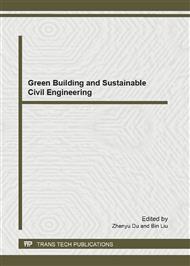p.84
p.90
p.95
p.100
p.104
p.109
p.113
p.118
p.122
The Study on Low-Carbon Building Using Natural Air Condition
Abstract:
At the present time, the CO2 emissions by the buildings take up about 50% on the total emissions of CO2, so the design of the low-carbon building and the application of the sustainable economizing technology is a great importance for lowering carbon. The article is different from other researches that mainly associated with high-performance materials and complex system. Based on the energy consumption rule and principle of controlling from source that means problem should be eliminated from the origins of the buildings energy consumption, the article gives more regard to the sustainable about the application of economizing system and low-carbon building. Avoiding the complex system that will bring cost in maintenance and make difficulty for users, enhancing fluidity, flexibility and dispersion of environment control, bring activity of building space to the life in the building, making the lifestyle to play more role in controlling indoor space will make the building be a true low-carbon building.
Info:
Periodical:
Pages:
104-108
Citation:
Online since:
October 2012
Authors:
Keywords:
Price:
Сopyright:
© 2012 Trans Tech Publications Ltd. All Rights Reserved
Share:
Citation:


